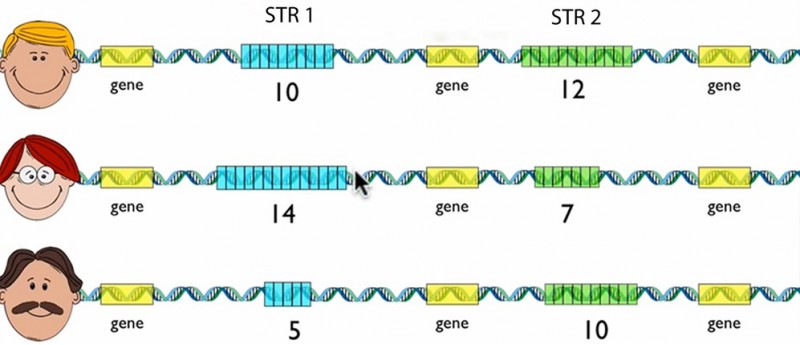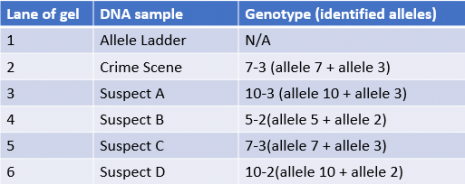A Brief History of Forensic analysis
Forensic sciences describe the boundary between science and the law. Science can as easily convict someone of a crime as free someone wrongly convicted. The earliest uses of science for criminal investigations involved the use of photographs to document crime scenes. Fingerprint evidence has been in use for the past 100 or so years.



Photographs Fingerprint Blood types
Blood typing
The first genetic tests were based not on DNA at all, but on blood types. There are 4 blood groups, or types – A, B, AB, and O. The test for blood groups is very fast and straight-forward. However, 40% of the population is type O, so it's not particularly useful if it turns out that several of your suspects are type O.
RFLP


Restriction Fragment Length Polymorphism, or RFLP, has been the workhorse of forensic DNA profiling for many years. RFLP makes use of the fact that certain regions in our genomes have DNA sequences that are repeated over and over again (called Variable Number of Tandem Repeats, or VNTRs) next to each other. English geneticist Alec Jeffries found that the number of repeats at any particular location differs from person to person.
Although RFLP is a very powerful tool and has great discriminating potential, it is laborious, cannot easily be automated, and is time-consuming. As it depends on DNA sequences of relatively great size, DNA must be of at least reasonable quality, and not degraded. This makes it unsuitable for many crime scenes where there may be only a single hair implicating a suspect.
STR

Short tandem repeats (STRs) are similar to VNTRs, since they too describe regions of DNA where you see DNA sequences repeated over and over. In this case, the repeat sizes are smaller – sometimes only 2 nucleotides are repeated.
STRs are much easier to analyze than RFLPs. First, because they are small they are easy to amplify using PCR. Second, because they can be amplified by PCR, STR tests can be automated, with several tests (>10) usually being run at the same time. Third, even degraded DNA can generally give meaningful results.
What makes STR analysis so powerful is that several loci containing STRs can be analyzed at the same time. Individual tests can, at best, distinguish 1 out of every 2000 or so people. In combination, as few as 13 loci can discriminate between any two people in the world (with the exception of identical twins), living or dead.


The sample in lane 2, the Crime Scene DNA, has two alleles: 7 and 3. The genotype of the Crime Scene DNA is then 7-3 (or 3-7). The genotype of the next sample is 10-3, the next sample is 5-2, and so on.
The final step in the experiment is to examine the results and determine whether there is a match between the Crime Scene DNA and any of the DNA samples obtained for analysis for the investigation. Samples that don't match the Crime Scene DNA can be excluded from the investigation; samples that do match the Crime Scene DNA are included as part of the suspect pool.
What's next?
- Mitchondrial DNA (mtDNA) with high copy number
- Amplified fragment length polymorphism (AFLP) a PCR-based variation of RFLP in which sequences are selectively amplified using primers.
- Genomic sequences or patterns called single nucleotide polymorphisms, or SNPs.
Test Speed vs. Power of Discrimination
 In forensic DNA analysis, there is always a balance between speed, cost effectiveness, and the power of discrimination. STR analysis is the current method of choice as it is highly discriminating, and can be performed in a matter of hours. The other methods are either lacking in their ability to discriminate between two DNA profiles, or are too laborious or lengthy. That is not to say that they aren't used in forensic analysis. In addition, with improvements in technology and increasing information about the genome and mitochondria, it's likely that other methods may become favored over STR profiling.
In forensic DNA analysis, there is always a balance between speed, cost effectiveness, and the power of discrimination. STR analysis is the current method of choice as it is highly discriminating, and can be performed in a matter of hours. The other methods are either lacking in their ability to discriminate between two DNA profiles, or are too laborious or lengthy. That is not to say that they aren't used in forensic analysis. In addition, with improvements in technology and increasing information about the genome and mitochondria, it's likely that other methods may become favored over STR profiling.
Steps in forensic DNA sample processing

 沪公网安备31011802003750号
沪公网安备31011802003750号